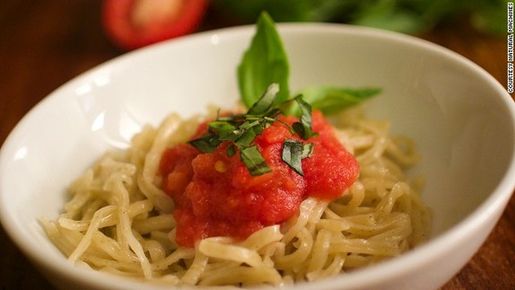
|
As further proof that you can now 3D-print anything, a company called Natural Machines has introduced a 3D printer for food. The "Foodini," as it's called, isn't too different from a regular 3D printer, but instead of printing with plastics, it deploys edible ingredients squeezed out of stainless steel capsules: "It's the same technology," says Lynette Kucsma, co-founder of Natural Machines, "but with plastics there's just one melting point, whereas with food it's different temperatures, consistencies and textures. Also, gravity works a little bit against us, as food doesn't hold the shape as well as plastic." At the Web Summit technology conference in Dublin, the Barcelona-based startup is showing off the machine, which it says is the only one of its kind capable of printing a wide range of dishes, from sweet to savoury. "In essence, this is a mini food manufacturing plant shrunk down to the size of an oven," Kucsma said, pointing out that at least in the initial stage the printer will be targeted mostly at professional kitchen users, with a consumer version to follow, at a projected retail price of around $1,000. In principle, the Foodini sounds like the ultimate laziness aid: press a button to print your ravioli. But Natural Machines is quick to point out that it's designed to take care only of the difficult and time-consuming parts of food preparation that discourage people from cooking at home, and that it promotes healthy eating by requiring fresh ingredients prepared before printing. Nevertheless, the company is working with major food manufacturers to create pre-packaged plastic capsules that can just be loaded into the machine to make food, even though they assure these will be free of preservatives, with a shelf life limited to five days. The printing process is slow, but faster than regular 3D printing. Other than being capable of creating complex designs, such as very detailed cake decorations or food arranged in unusual shapes, the Foodini can be useful for recipes that require precision and dexterity, like homemade pizza or filled pasta. Currently, the device only prints the food, which must be then cooked as usual. But a future model will also cook the preparation and produce it ready to eat. The idea also comes with a social element too. "There's a touchscreen on the front that connects to a recipe site in the cloud, so it's an internet-of-things, connected kitchen appliance," said Kucsma. Users will also be able to control the device remotely using a smartphone, and share their recipes with the community. |
最近一家名叫“自然机器”(Natural Machines)的公司称他们已有可以打印食物的3D打印机。这似乎是要进一步证明现在3D打印可以用于任何领域。 这台名叫“Foodini”的机器和其它普通的3D打印机差别不大,但是它的原料并不是塑料,而是将食材捣成泥状装进干净的钢制胶囊盒里,机器可以通过操作胶囊盒完成食物的打印。自然机器公司的创建人之一利奈特·库斯马(Lynette Kucsma)表示“Foodini使用的技术跟其它3D打印机一样。不同的是,打印塑料的机器只有一个熔点,而打印食物的机器需要设置不同的熔点来适应不同的温度、粘稠度和食物材质。而且重力也是一个很棘手的问题,因为泥状食物不像塑料那样,它会因重力而变形。” 在都柏林(Dublin)举行的网络技术峰会上,这家位于巴塞罗那的创业公司展示了这台机器,并称这是唯一一种能够打印各种各样的食物的3D打印机,无论是甜点还是开胃菜都不在话下。 “其实它就是一个缩小到跟烤箱一样大的小型食品加工厂,”库斯马说道,他表示至少在最初阶段foodini的目标客户是专业厨师,接下来还有会有针对大众的版本,零售价格预计在1000美元左右。 Foodini听起来像是懒人的终极福利:按一下按钮,你就可以享受你的方饺了。但自然机器公司很快回应说,这台机器的目的只是帮助人们省去最耗时最复杂的食物制作工序,并且要求用户准备新鲜的食材作为打印原料,提倡健康饮食。 不过,目前该公司仍在和主要的食品制造商合作,旨在研发出预先装好食材的塑料胶囊盒。这种包装好的胶囊盒能够直接放在机器上打印食物。该公司强调这些胶囊盒不添加防腐剂,因此保质期仅有五天。 Foodini打印食物的速度较慢,但快于普通的3D打印机。除了可以打印造型复杂的食物如精美的蛋糕装饰品或特殊摆盘的菜肴外,它还可以满足一些食谱对食材克数精确度和菜肴设计灵巧性的要求,比如自制披萨饼或意大利面。 目前机器打印出的食材需要再进行常规的烹饪,但未来的机器可以自动将食材加工成可食用的成品。 这台机器还具有社交功能。库斯马表示,机器前面有一个触摸屏,它可以连接到云端里的食谱网站,所以这也算是一个物联网连接着厨房设备。用户可以通过智能手机远程操控这台机器,也能将菜谱上传到网上与朋友分享。 (译者:eileen7,编辑:Helen) 扫一扫,关注微博微信   |
|
|